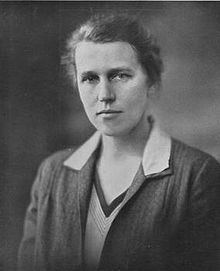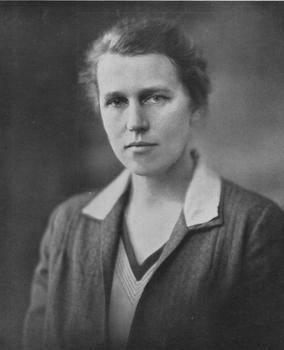Nationality American Occupation educator | Name Hilda Smith Died March 3, 1984 | |
 | ||
Born June 19, 1888 ( 1888-06-19 ) New York City Known for Bryn Mawr Summer School for Women Workers in Industry/She-She-She Camps/Worker Education | ||
Hilda Worthington Smith (June 19, 1888 – March 3, 1984) was an American labor educator, social worker, and poet. She is best known for her roles as first Director of the Bryn Mawr Summer School for Women Workers in Industry and as a co-founder of the Affiliated Schools for Workers (later known as the American Labor Education Service), though she also had a long career in government service supporting education for underserved groups including women, labor workers, and the elderly.
Contents
- Early life and education
- The Bryn Mawr Summer School for Women Workers in Industry
- The Visit
- Later Career and Life
- Life Philosophy
- Published works
- References

Early life and education
Worthington Smith was born in 1888 in New York City. Her father's invention of a steamheating system, which heated many of the early office buildings of New York, provided the family with a plush fortune. She attended Bryn Mawr College between 1906 and 1910 for her undergraduate degree, during which she was elected to lead the student body as president of the Self Government Association. Worthington Smith remained at Bryn Mawr the following year and left in 1911 with a master's degree in ethics and psychology, after which she received a second graduate degree from the New York School of Philanthropy (which exists currently as the Columbia University School of Social Work). When she was twenty-five years old she returned to Bryn Mawr at the invitation of President of the College, M. Carey Thomas, to oversee a residence hall as a Warden (p. 42), and began to teach an informal class on social work at the request of a group of undergraduates in which she introduced the concepts of child welfare, family rehabilitation, delinquency, immigration, and housing. (p. 44). She returned to her studies at the School of Philanthropy in 1914 and soon established a community center for youth in New York City that served many boys of Irish, Italian, and African American descent, which she ran until M. Carey Thomas offered her the position of Acting Dean in 1919. In the two years that she served as Dean, her interest in workers' education was already becoming an area of active pursuit: in addition to her duties mentoring undergraduate students and administering college programs, Smith took the initiative to arrange night classes for the black college gardeners and service employees (p. 16).
The Bryn Mawr Summer School for Women Workers in Industry
A pivotal moment in Worthington Smith's career came in 1921, when President Thomas asked her to head the Bryn Mawr Summer School for Women Workers in Industry, a brand new initiative that Thomas envisioned and set into motion after visiting Workers' Educational Association programs in England. Though Thomas was the original visionary of the school, Worthington Smith is credited with developing it into the immensely successful program that it became and setting the example for a host of other similar programs that were founded in its image, including the Wisconsin Summer School, Barnard Summer School, Vineyard Shore School, Southern Summer School, and the coeducational Hudson Shore Labor School. The Summer School was a residential program on the campus of Bryn Mawr College that operated for 8 weeks in the summer every year (except for 1935) between 1921 and 1938, hosting and educating female factory workers from all over the country who numbered approximately 1700 over the duration of the initiative. Money was raised for scholarships to support the students, who were between the ages of 18 and 35 and came from diverse backgrounds including different nationalities, races, religions, industries, non-unionized and union affiliations. About 100 women attended each year that the school operated, gathering to live, eat, and sleep together while they studied a variety of liberal arts subjects with distinguished faculty drawn from local institutions.
The object of the school, as stated in prospectus and distributed to a variety of news outlets, was "to offer young women of character and ability a fuller education and an opportunity to study liberal subjects in order that they might widen their influence in the industrial world, help in the coming social reconstruction and increase the happiness and usefulness of their own lives." The focus was therefore on giving women the knowledge and tools to exercise agency in their lives, and to become leaders in their communities in a new era of social change.
Ms. Thomas had come into contact with the workers' education movement while traveling thru England and the Scandinavian countries after World War I. Determining that this country needed a version of this school she chose Dean Smith to start it. Ms. Smith directed the school for its first 13 years, first at Bryn Mawr, then later at West Park, N.Y., at her family home, HeartsEase.
By 1927 there were a group of labor schools called the Affiliated Schools for Workers directed by Ms. Smith. This was the hotbed of reform where the future educators (including Eleanor G. Coit, Ernestine Friedmann, Marie Algor, Amy Bruce, Alice Shoemaker and Louise Leonard McLaren) would emerge on the labor scene. Later the name was changed to the American Labor Education Service Inc., which last held a conference on April 28, 1962. labor education had gained a firm foothold in American education by then due to being championed by Ms. Smith and her cadre of friends from her Bryn Mawr days in the 20's.
In 1933 Harry Hopkins, as adviser to FDR and head of the FERA, borrowed Ms. Smith to set up an educational program for the Administration, which in 1937 became the W.P.A.'s Workers Education Service. As FDR's Educational Specialist, She created and ran multiple programs; one such program employed out-of-work teachers, whose graduates include Hubert H. Humphrey, a future vice president under LBJ. Another set up the She-She-She Camps for unemployed women, ER's bid to place women in the program of Civilian Conservation Corps camps for men, and to provide education and housing for unemployed youth.
The Visit
Eleanor Roosevelt's journal of August 2, 1939 notes her visit to her friend at the school for women she ran during the summer months. She arrived at the Hudson Labor School, at tea time and joined the group of women in the shade of the trees. Hilda Smith owned the property and used it as a summer school for women workers. Eleanor wrote; "The group was gathered in front of the house under the trees before I arrived and they asked me some interesting questions. "What did I think they should try to get out of the seven weeks spent on the banks of the Hudson?" "How would one go about interesting people in a community in working conditions?", etc.
There were two English girls, a German refugee and a Swedish girl at the school that summer. While we were all having tea, I was amused to have one of the English girls say to me: "What a contrast between what you are able to do and what our Queen is free to do. I wonder if she would not give a great deal to have the same amount of freedom?" She continued, "I am sure this school does a great deal to develop the mental abilities of the girls, but I think it is equally valuable because of the health which they acquire, for they do all their studying practically out of doors, eat on the balcony, and swim and play together."
ER knew the value of this, having championed the work Hilda Smith pioneered in convincing FDR to give up funds for the formation of the She-She-She Camps in 1933 when he as part of the New Deal created the CCC(Civilian Conservation Corps). The camps fell victim to politics and sexism and were closed by 1937, where the twin crises of shelter (200,000 women were homeless in 1933) and hunger plaguing the destitute eased as a result of the new deal programs of FDR.
Later Career and Life
The workers' education movement gained momentum, with Worthington Smith playing an active and significant role. In addition to the schools that she was directly involved in founding (such as the Hudson Shore Labor School, which was established on the site of her family home on the Hudson River), she served on the advisory committees of many such initiatives. She also established and served as first Director of the Affiliated Schools for Workers (1927–1939), later known as the American Labor Education Service (1939–1962).
The later years of Worthington Smith's career were dominated by federal appointments, listed here:
Worthington Smith retired at the age of 83 to focus on various writing projects related to her life experiences and career, including a narrative of her seven years with the Office of Economic Opportunity and a revised and expanded version of her autobiography, Opening Vistas in Workers' Education, which was self-published in 1978. In addition to these publications, Worthington Smith's poetry was published in songbooks, periodicals, and in three printed volumes: Castle of Dream (1910) and Poems (1964), both privately printed, and Selected Poems (1977). She died on March 3, 1984.
Life Philosophy
To sum up Jane's life a story done in 1984 for the New York Times does come close to sewing 1919 to 1983 into a fine embroidery. The author noted that in 1937 the programs Smith initiated but couldn't in 1933 call by name became the W.P.A.'s Workers Education Service. When tasked by Harry Hopkins to be education specialist she already knew what she wanted.
Smith also wanted to teach "workers’ education", a term that had a strong communist association. She related years later, "I hardly dared mention it because it was so unpopular."
Workers'education was ... "unusual because it involved three groups virtually ignored at the time: women, blue collar workers, and blacks.."—Priscilla Van Tassel, New York Times, June 24, 1984, NJ5. (Caption for HWSmith picture) from the interview for the story in the NYTimes
"And what is workers' education? I think the first thing is to say what workers' education is and what it is not. I'd like to say, first, it is not vocational education. Many people think that that is what it is; it's not trade training for workers. That's entirely separate, should supplement workers' education and go along with it. But it is not the same thing. Workers' education is a specialized branch of adult education. It covers in general the economic and labor problems related to the experience of industrial workers, office workers, farmers, anything that touches the economic field. It is also and usually supplemented with much work in English, with elementary science, social psychology, with history, with a background of life in the United States. It touches: employers' problems, trade union problems, the worker in the community as citizen, the government's relation to industry and to the labor movement."
Interview with Hilda Worthington Smith, Franklin D. Roosevelt Library, Hyde Park, NY, October 17, 1963
Published works
Worthington Smith's published works include:
